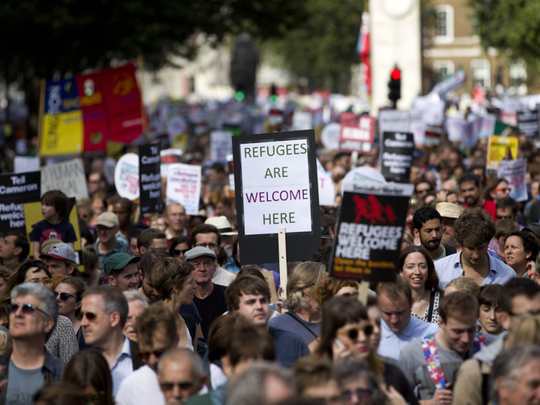
I love seeing Europeans line up in airports to applaud arriving refugees. But humanitarianism will not guide policy for long. We liberals need to argue from Europe’s self-interest: our continent has the need, the space and the ability to accept people. Here’s the pragmatic manifesto for welcoming refugees into Europe.
Many European countries are gradually turning into old people’s homes. Germany, Italy, Spain and others have some of the lowest birth rates in human history. About one-third of their populations will be aged over 65 in 2050, predicts the Pew Research Cenre in the US. Germany needs to import at least 350,000 people a year to keep its workforce stable, calculates the German foundation Bertelsmann Stiftung. Suddenly, young wannabe workers are piling into the country as if summoned by a genie with a lamp. No wonder Angela Merkel has been more welcoming than David Cameron, whose country is younger.
But all over Europe, carers for old people are already scarce. Norway found oil under the seabed but it would have been better off if it had discovered 50,000 nurses there instead. In 2050, I plan on being 80. Either I’ll be cared for by a robot or by a Syrian.
Many right-wingers think we have reached our limits. “KEEP OUT, BRITAIN IS FULL UP”, said a fairly typical front page in the Daily Express newspaper in 2009. This feeling is widespread. And it’s true that western Europe is one of the most densely populated regions on earth. Indeed, density has long been Europe’s unique selling point: with so many people of different nations closely packed together, we have always traded goods and exchanged ideas fast. That’s why the scientific revolution of the 16th and 17th centuries happened here. Density still appeals: some of Europe’s highest housing prices are in the densest cities.
But we have plenty more room. Many European cities aren’t dense enough. Places such as Brussels, Dublin and others sprawled during the automobile era. Now east Germany, north-western Spain and gorgeous mountain villages in Italy are losing people. Lots of cities have unused industrial land. We can make space for newcomers through densification, says Stephanie Wunder, senior fellow of the Ecologic Institute in Berlin.
Humans inhabit a minute slice of the EU’s territory. Only about 2.5 per cent of the EU’s land is used for housing, estimates the European Commission. By contrast, a whopping 43 per cent was used for agriculture in 2009, it says. That’s too much. Already, agriculture’s share of the land “is steadily diminishing, because we’ve increased agricultural productivity tremendously”, says Allan Buckwell, senior fellow at the Institute for European Environmental Policy.
We could turn more arable land into forest or into green landscapes where people can relax and play. Making that transition is feasible because we now use agricultural land inefficiently. Above all, we devote lots of land (and pay Argentina, the US and others to devote land) to growing crops to be eaten by cows that we then eat. This is a very roundabout way of feeding ourselves.
We should divert land away from servicing animals, especially cows. That’s firstly because cows cause climate change. Their burps produce the greenhouse gas methane. Livestock supply chains generate 14.5 per cent of all human-caused greenhouse gases, says the UN’s Food and Agriculture Organisation.
Strike two against cows: Europeans eat too much meat and dairy. The average German consumes 60 kilograms of meat a year, whereas the recommended healthy maximum is 30 kilograms, according to Germany’s Fleischatlas (Meat Atlas).
I’m not suggesting abolishing the cow. Grass-fed cattle graze on pretty pastures that help capture carbon, note Buckwell and Wunder. These outdoor cows are also semi-sacred icons of the European landscape. Beef can survive as a delicacy but not as a staple food.
Migrants often spend years locked up together in grim government-funded “migrant centres”. However, the way to learn a new country’s language, make friends and find work is to live with a local.
This crisis has shown that lots of Europeans are willing to take refugees into their homes. After Iceland’s government said it could take only 50 Syrian refugees, many Icelanders came forward offering to take a far greater number into their own homes. “I’m a single mother with a six-year-old son,” wrote Hekla Stefansdottir (as translated by AFP). “We can take a child in need. I’m a teacher and would teach the child to speak, read and write Icelandic and adjust to Icelandic society. We have clothes, a bed, toys and everything a child needs. I would of course pay for the airplane ticket.”
People such as Stefansdottir aren’t just sitting around waiting for government to do something. Here is the Big Society of volunteers that Cameron used to talk about.
We need migrants, and we can accommodate them. If opponents just don’t like foreigners, they should say so instead of pretending to be hardheaded pragmatists.
— Financial Times








